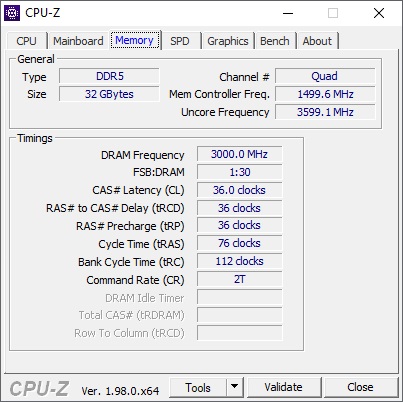Intel Alder Lake DDR5 Memory Scaling Analysis With G.Skill Trident Z5
by Gavin Bonshor on December 23, 2021 9:00 AM ESTG.Skill Trident Z5 Memory (F5-6000U3636E16G)
2x16GB of DDR5-6000 CL36
For the purposes of this article and to investigate scaling performance on Alder Lake, G.Skill supplied us with a kit of its latest Trident Z5 DDR5-6000 CL36 memory. The G.Skill Trident Z series has been its flagship model for many years, focusing on performance but blending in a premium and clean-cut aesthetic. G.Skill offers two types of its Trident Z5 memory, some without RGB LEDs such as the kit we are taking a look at today (Z5), and the Trident Z5 RGB, which includes an RGB LED light bar along the top of each memory stick.
Focusing on the non-RGB variants, the G.Skill Trident Z D5 is available in various 32 GB (2x16) configurations starting at DDR5-5600 CL36 and ranging up to DDR5-6000 CL36. G.Skill unveiled a kit of Trident Z D5 RGB DDR5-7000 CL40 kit, which is extremely fast, and when it is released, it will ultimately be one of the most, if not the most, expensive DDR5 memory kit on the market.
Looking at the design, the G.Skill Trident Z5 DDR5 memory uses a 42 mm tall (at the highest point) heatsink, with G.Skill offering a two-tone contrasting matte black kit, as well as a black and metallic silver kit. The kit supplied to us by G.Skill uses two-tone matte black heatsinks. The heatsinks are constructed from aluminum, and G.Skill states that it uses a newer and more 'streamlined' design. There are quite pointy, which given previous G.Skill memory kits might have the tendency to feel too sharp when installing them.
Looking at what CPU-Z is reporting, we can see that the X.M.P 3.0 profile matches up with the advertised specifications, with this particular kit using DDR5-6000 with latency timings of 36-36-36-76. The operating voltage for the kit is 1.3 V, which is a 0.2 V bump from the JEDEC SPD rating of this kit, which is DDR5-4800 at 1.1 V.
Checking the more intricate details of the G.Skill Trident Z5 DDR5-6000 memory, CPU-Z reports that the kit is using Samsung IC's, with a 1Rx8 array of 16 Gb ICs employed on each module. While CPU-Z doesn't actually report this, we reached out to G.Skill who informed us that this kit uses a single rank design.













82 Comments
View All Comments
bananaforscale - Wednesday, December 29, 2021 - link
That's DDR4 vs GDDR5, not DDR4 vs DDR5. GDDR is dual ported and can be read from and written to at the same time.29a - Sunday, January 2, 2022 - link
Do you have a source for that for those of us who don't want to take your word? Also this article is about ddr5 memory scaling so I don't know why they half assed the article and didn't do iGPU testing.gagegfg - Thursday, December 23, 2021 - link
I do not understand how in the gaming tests of a top-of-the-range processor and last generation memory combined with a GPU almost 5 years old and 4K and 1440 resolutions, that analysis is really meaningless, they have a terrible bottleneck.HammerStrike - Thursday, December 23, 2021 - link
Yeah, it’s bafflingly. I get the GPU shortage situation is an issue (although you can buy GPU’s, just at inflated prices, not to mention the industry contacts they have), but to test at 1440p / 4k at high settings on a 1080 is just… ignorant?Worse case if you are stuck with the 1080 test at 720p low settings to make the CPU and RAM as much a bottle neck as possible. What they did is just a waste of time.
Ian Cutress - Thursday, December 23, 2021 - link
Ever tried going to a GPU vendor, asking for 2-4+ of the same high-end GPUs (for concurrent testing), during a shortage, saying you can't promise them a review, just for testing? Even with the CPU stuff, it happens once every two generations, maybe, so trying to get one for our motherboard guy is nearly impossible. No we don't have the budget. People complain that I'm running RTX 2080 Ti cards on my CPU reviews. Either we run what we have and the article is written in that context, as mentioned right there on page one no less, or we don't run anything at all.andr_gin - Thursday, December 23, 2021 - link
I understand your problem about not having high end GPUs, but why not at least reduce resolution to 720p?Ryan Smith - Thursday, December 23, 2021 - link
That's an unforced error on our part. We're going to run the numbers for 720p and update the article. Thank you for the feedback.Oxford Guy - Friday, December 24, 2021 - link
More important is DDR-4 data for comparison, particularly at low latencies and nothing below 3200 speed.shabby - Saturday, December 25, 2021 - link
I find it hard to believe you can't source a video card, no other reviewers have this issue and I bought two myself this year.Ooga Booga - Tuesday, December 28, 2021 - link
1) Go to Oxford for transistor studies2) See moron youtubers become millionaires running canned benchmarks
3) Still refuse to leave Anandtech